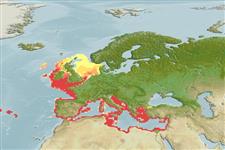Common names from other countries
Environment: milieu / climate zone / depth range / distribution range
Ecologia
; intervalo de profundidade 25 - 200 m (Ref. 2754). Subtropical
Northeast Atlantic, Mediterranean and Black Sea.
Length at first maturity / Tamanho / Peso / Idade
Maturity: Lm ? range ? - ? cm Max length : 4.8 cm SHL macho/indeterminado; (Ref. 2758)
Depth based on occurrence (Ref. 2758, p. 805); to be replaced with better reference. Minimun depth from Ref. 2758. Main food and feeding type based on another species of the same Genus; to be replaced with a better reference (Ref. 95810).
Life cycle and mating behavior
Maturidade | Reprodução | Desova | Ovos | Fecundidade | Larvas
Members of the class Bivalvia are mostly gonochoric, some are protandric hermaphrodites. Life cycle: Embryos develop into free-swimming trocophore larvae, succeeded by the bivalve veliger, resembling a miniature clam.
Demir, M. 2003. (Ref. 2754)
Status na Lista Vermelha da IUCN (Ref. 130435)
Status no CITES (Ref. 108899)
Not Evaluated
Not Evaluated
Uso pelos humanos
| FishSource |
Ferramentas
Fontes da internet
Estimates based on models
Preferred temperature
(Ref.
115969): 7 - 15.8, mean 10 (based on 403 cells).
Vulnerabilidade
Low vulnerability (10 of 100).
